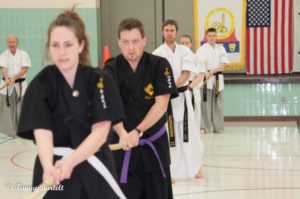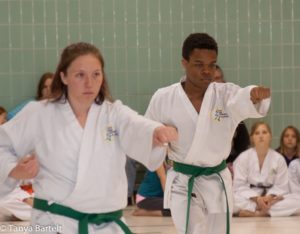 So, you’ve been training for quite a while and know all the basic movements. You work hard to make the basics correct. Now, as you work on your patterns, techniques aren’t fitting. Are you doing techniques differently than during basics? Why?
So, you’ve been training for quite a while and know all the basic movements. You work hard to make the basics correct. Now, as you work on your patterns, techniques aren’t fitting. Are you doing techniques differently than during basics? Why?
Have you found the combinations that are the same in different patterns? Have you discovered the progression that happens as you learn patterns? Have you worked toward making the similar movements recognizable across a set of patterns?</span>
[Haidong Gumdo] There was a little fun had cutting milk jugs. The first couple students missed the jug on the first 3-4 cuts. Finally, a student stops and asks “Why are our techniques worse when there’s a target?” It got a good laugh but it also made a very good point. Why do techniques change when we add targets?</span>
My thought is that basic cuts are the most correct cuts that you can do. This makes their practice vital. That your efforts are focused on making each repetition better than the previous…better than the last class. Your cuts should always be the same as during basic cuts.</span>
 [Taekwondo] This is no different in Taekwondo. Your blocks, strikes, and kicks should be done in drills to be the most correct that you can make them. Speed and power development as well as precision always need development.</span>
[Taekwondo] This is no different in Taekwondo. Your blocks, strikes, and kicks should be done in drills to be the most correct that you can make them. Speed and power development as well as precision always need development.</span>
<span style=”font-family: arial, helvetica, sans-serif; font-size: 12pt;”>Now that you’re paying closer attention the your techniques, the challenge is to not change them when you transfer basic movements to patterns. If a stance is done a specific way during drills, then it should look the same in your patterns. Your movements should look just like drills just in a mixed up order.
The applications of the techniques should be visible during your patterns. These applications have only minor variations (usually targeting) and are still performed the same across many patterns. Combinations work because the techniques fit together well enough to be successfully used. Those that didn’t work were discarded.
Your techniques have been developed and now it’s time for the next portion of your training. My students have heard me repeat the saying that a handful of my teachers all used. They’re told “Physical techniques are only 10% of an art.” This means that there is the other 90% of the art that has way much more for you to learn.
 The benefits of self control, self discipline, and focus are all within the martial arts BUT they’re not in obvious lessons. Just because you came to class doesn’t mean that you learned them. Self control comes from working through the frustrations of learning new techniques or patterns. Self discipline comes from returning to class and working on the material. Focus comes from following directions and developing awareness. All of these, then, help to develop an indomitable spirit.
The benefits of self control, self discipline, and focus are all within the martial arts BUT they’re not in obvious lessons. Just because you came to class doesn’t mean that you learned them. Self control comes from working through the frustrations of learning new techniques or patterns. Self discipline comes from returning to class and working on the material. Focus comes from following directions and developing awareness. All of these, then, help to develop an indomitable spirit.
Once the recognition of how these traits develop, then they can be applied to other topics/subjects to become successful in all of the adventures you undertake…even when they aren’t things you’re interested in.
![]()
